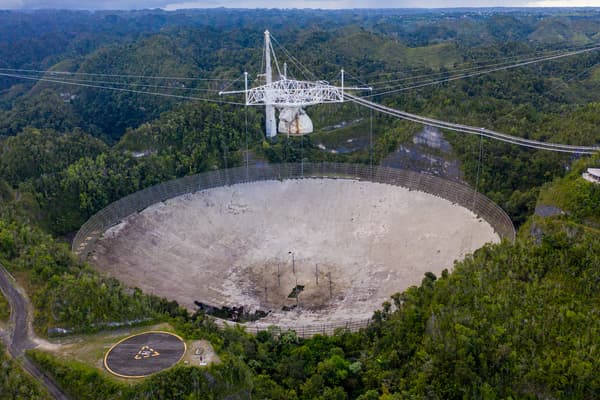A hunt that lasted a quarter of a century: the background noise emitted by the whirlwind of gigantic black holes has been identified for the first time by astronomers thanks to an unprecedented technique for detecting gravitational waves, which opens “a new window on the Universe”.
These results, released Thursday, are the result of extensive collaboration of the world’s largest radio telescopes. They managed to capture this vibration of the Universe with “the precision of a clock”, the authors of the work published simultaneously in several scientific journals enthuse.
Violent phenomena but weak signals
Predicted by Einstein in 1916 and detected a hundred years later, gravitational waves are tiny distortions of space-time, similar to ripples in water on the surface of a pond. These oscillations, which propagate at the speed of light, are born under the effect of violent cosmic events such as the collision of two black holes.
They may be linked to massive phenomena, but their signal is extremely weak. In 2015, the Ligo (United States) and Virgo (Europe) gravitational wave detectors revolutionized astrophysics by detecting the ultra-short tremor -less than a second- from collisions between stellar black holes, with a mass ten times greater than that of the Sun. .
This time, a signal much longer extended in time reveals a larger-scale phenomenon, captured by a network of radio telescopes (from Europe, North America, India, Australia and China) of the International Pulsar Timing Array Consortium (IPTA).

We are talking here about gravitational waves generated by black holes of “several million to several billion times the mass of the Sun,” Gilles Theureau, an astronomer at the Paris-PSL Observatory, who coordinated the work on the French side, told AFP.
The “ticking” of pulsars, “natural clocks”
To detect these waves, the scientists used a novel tool: pulsars of the Milky Way. These stars have the particularity of having a mass of one to two suns, compressed into a sphere of about ten kilometers in diameter.
Ultra-compact, these stars rotate on themselves at high speed, up to 700 revolutions per second, specifies the CNRS researcher. A crazy rotation that produces magnetic radiation at the poles, like the rays of a lighthouse, detectable thanks to radio waves emitted at low frequencies. At each turn, pulsars emit ultra-regular “beeps”, making them “remarkable natural clocks”, explains Lucas Guillemot, from the Laboratory of Physics and Chemistry of the Environment and Space (LPC2E) in Orleans.
Scientists have enumerated groups of pulsars to obtain a “celestial mesh” in the meanders of space-time. They were able to measure a small interruption in its ticking, with “changes of less than a millionth of a second over more than 20 years,” according to Antoine Petiteau of the Atomic Energy Commission (CEA).
These delays were correlated, a mark of a “disturbance common to all pulsars,” according to Gilles Theureau: the characteristic signature of gravitational waves. “It was a magical moment,” said Maura McLaughlin of the US network Pulsar Search Collaboratory during a press conference.
like in a noisy restaurant
What is the source of these waves? The preferred hypothesis points to pairs of supermassive black holes, each one larger than our solar system, “ready to collide”, develops Gilles Theureau. Antoine Petiteau describes two giants “turning around before merging”, a dance that causes gravitational waves of “a period of several months to several years”.
A continuous background noise that Michael Keith, from the European network EPTA (European Pulsing Timing Array), compares to a “noisy restaurant with lots of people talking around you”.
The measurements still do not allow us to say if this noise betrays the presence of some pairs of black holes or of an entire population. Another hypothesis suggests a source in the earliest ages of the Universe, when it experienced the so-called period of inflation.
Studies to explore
“We are opening a new window to the Universe”, greets Gilles Theureau.
“We are adding a new range of information vectors”, complementary to the research of Ligo and Virgo, which operate at different wavelengths, Antoine Petiteau abounds. In particular, this could clear up the mystery of the formation of supermassive black holes.
However, studies will need to be deepened to claim fully robust detection, which is expected within a year. The absolute criterion is “that there is less than one chance in a million that this will happen by chance”, underlined the Paris Observatory, the CNRS, the CEA and the universities of Orléans and Paris Cité, in a statement.
Source: BFM TV

